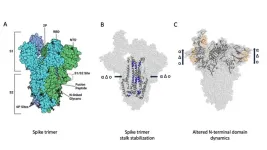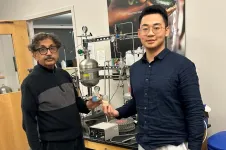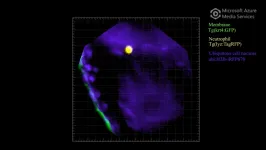(Press-News.org) UNIVERSITY PARK, Pa. — Just as a tight core is a component of good physical fitness for humans, helping to stabilize our bodies, mutations that tightened the core of the SARS-CoV-2 spike protein in new variants may have increased the virus’s fitness.
New research led by Penn State reveals that the stem region of the spike protein became progressively tighter over time, and the team thinks this likely improved the virus’s ability to transmit through nasal droplets and infect host cells once in the body. The team said the stem region of the protein that emerged in the most recent Omicron variants is as rigid as it can get, which could mean that newer vaccines may be effective for longer than the ones that targeted the original variant.
“We wanted to see how the spike protein morphed structurally as it evolved from the original wild-type strain of the virus, through the alpha, delta and most recently Omicron variants,” said Ganesh Anand, associate professor of chemistry and of biochemistry and molecular biology, Penn State. “We found that the spike protein was initially more flexible at the stem region, which is where the spike protein is bundled together, but over time, mutations caused the protein to become progressively tighter and more rigid, and we think it’s now as rigid as it can get. This is important because it means that vaccines that are developed to target the current variant with these rigid spike proteins are likely to be effective for much longer than previous vaccines against the more flexible wild-type strain.”
To study how the spike protein changed with each of the new variants, the team studied the virus in vitro (in a test tube) using a technique called amide hydrogen/deuterium exchange mass spectrometry.
Anand explained that the SARS-CoV-2 spike protein is composed of three chain molecules called monomers that are bound together to form a trimer. The spike protein is made up of two subunits, an S1 and S2 subunit. The S1 subunit contains a receptor binding domain while the S2 subunit contains the stem region responsible for bundling the trimer.
“It is analogous to a tree, with the stem forming the trunk and the receptor binding domain forming the branches,” said Anand.
The team’s results, which published in the journal eLife, revealed that the spike protein stem first became more rigid with the D614G mutation, which is common to all SARS-CoV-2 variants. The stem became progressively more twisted with the emergence of new mutations in subsequent variants, and the Omicron BA.1 variant showed the largest magnitude increase in stabilization relative to preceding variants.
Why would the virus benefit from a tighter core?
“We did not study the virus in patients, so we cannot determine if the changes we observed in the spike protein directly affected the newer variants such as Omicron’s ability to transmit more readily; however, we can say that the changes likely made the virus more fit, which could translate to better transmission,” said Anand. “A tighter core could likely make the virus more stable in nasal droplets and faster at binding to and entering host cells. So, for example, what initially took about 11 days to develop an infection after exposure now takes only about four days.”
Anand noted that one of the reasons the vaccines have not been able to fully neutralize the virus is because they were generated against the spike protein of the original wild-type variant.
“The latest bivalent booster — which targets newer variants — helps, but people who never got this booster aren’t receiving this more targeted protection,” he said. “Future vaccines that focus specifically on Omicron are likely to be effective for longer.”
Finally, Anand said that the spike protein has now become so tightly twisted that it is unlikely to structurally change further at the stem region.
“There are limits to how much it can tighten,” he said. “I think that we can have some cautious optimism, in that we’re not going to continuously have variants emerging, at least tightening is not going to be a mechanism.”
Other Penn State authors on the paper include chemistry graduate students Sean Braet, Theresa Buckley and Varun Venkatakrishnan. Kim-Marie Dam, postdoctoral research fellow, and Pamela Bjorkman, assistant professor of biology and biological engineering, Caltech, also are authors.
END
A tighter core stabilizes SARS-CoV-2 spike protein in new emergent variants
Mutations made spike protein more rigid, potentially improving virus’s fitness
2023-03-31
ELSE PRESS RELEASES FROM THIS DATE:
Status epilepticus: New inflammatory markers to improve patient care
2023-03-31
A rare and nevertheless formidable event in the landscape of epilepsies, New-Onset Refractory Status Epilepticus (NORSE) is a form of prolonged seizure in which the neurons of the epileptic focus endure a continuous discharge of neurotransmitters. It is a medical emergency requiring intensive care management. Indeed, it can cause significant long-term neurological sequelae and is associated with an average mortality rate of 12% in children and 16 to 27% in adults. NORSE can occur in response to an infection or tumor development. However, its origin remains unknown in half of the affected patients despite extensive clinical and biological ...
Making rare cell types visible: Researchers are developing a new method
2023-03-31
The human body contains more than 30 trillion cells. Until recently, the sheer number of cells in the organism meant that approaches to understanding human diseases and developmental processes based on the analysis of single cells were a futuristic vision. The development of new sequencing methods is currently revolutionising our understanding of cellular heterogeneity. These technologies can detect rare or even new cell types by extracting and sequencing the genetic information from the cells based on ribonucleic acid chains.
In cooperation ...
More than 1,200 LOINC® registrants represent 78 countries for version 2.74 webinar
2023-03-31
INDIANAPOLIS -- LOINC®, an international data standard maintained at Regenstrief Institute, hosted an educational release webinar for version 2.74. More than 1,200 participants signed up, representing 78 countries.
The hour and a half webinar served as an opportunity for the LOINC team to introduce and explain the new concepts from the 2.74 release update. Participants were presented with opportunities to learn more about each new concept and ask questions.
LOINC, short for Logical Observation Identifiers Names and Codes, is a global standard for health terminology. Created and maintained at Regenstrief, LOINC enables the identification, exchange and collection of data across ...
NRG Oncology combined trial long-term results indicate that pathologic complete response is prognostic of outcomes for soft tissue sarcoma patients
2023-03-31
Combined long-term survival results from nonrandomized phase II trial NRG Oncology RTOG 0630 and the ancillary analysis of the combined NRG-RTOG 0630/9514 trials indicate that pathologic complete response (pCR) is associated with improved survival outcomes for patients with localized soft tissue sarcoma (STS) who receive preoperative chemoradiotherapy or radiotherapy. This data suggests that pCR can be used as a prognostic factor for clinical outcomes in future STS research. These results were recently published in the JAMA Oncology.
NRG-RTOG 0630 and 9514 both evaluated STS patients who were receiving either preoperative image-guided radiotherapy (IGRT; 0630) or neoadjuvant ...
Pensoft joins Advisory Panel to further develop the Journal Comparison Service by cOAlition S
2023-03-31
Back in December, we announced that Pensoft joined 27 other publishers in sharing prices and services via the Journal Comparison Service developed by cOAlition S, in order to boost transparency in scholarly publishing.
Now, we are up to another challenge: we have joined the Advisory Panel appointed by cOAlition S to help further the improvement and development of this important service. The Advisory Panel consists of twelve members (six publishers and six end-users) representing different stakeholders in the scholarly communication ecosystem.
Journal Comparison Service (JSC) is an initiative by cOAlition S aimed to improve ...
Scallop eyes as inspiration for new microscope objectives
2023-03-31
Some species of mussels can see. Scallops, for example, have up to 200 eyes that help them detect predators such as an approaching starfish. However, the eyes of scallops differ significantly from the human eye. While in our eyes the combination of cornea and lens creates an image on the retina, in scallop eyes light is focused by a hemispherical mirror.
Optical imaging with lenses or mirrors
Creating images with mirrors instead of lenses is especially common in astronomical telescopes, in order to capture as much light as possible from planets, stars and galaxies. In the Schmidt telescope developed in the 1930s by Bernhard Schmidt (1879-1935) and still in use in many observatories today, ...
Path to net-zero carbon capture and storage may lead to ocean
2023-03-31
Lehigh Engineering researcher Arup SenGupta has developed a novel way to capture carbon dioxide from the air and store it in the “infinite sink” of the ocean.
The approach uses an innovative copper-containing polymeric filter and essentially converts CO2 into sodium bicarbonate (aka baking soda) that can be released harmlessly into the ocean. This new hybrid material, or filter, is called DeCarbonHIX (i.e., decarbonization through hybrid ion exchange material), and is described in a paper recently published in the journal Science Advances.
The research, which demonstrated a 300 percent increase in the amount of carbon captured ...
Association between daily alcohol intake and risk of all-cause mortality
2023-03-31
About The Study: In this updated systematic review and meta-analysis of 107 studies involving more than 4.8 million participants, daily low or moderate alcohol intake was not significantly associated with all-cause mortality risk, while increased risk was evident at higher consumption levels, starting at lower levels for women than men.
Authors: Jinhui Zhao, Ph.D., of the University of Victoria in Victoria, British Columbia, Canada, is the corresponding author.
To access the embargoed study: Visit our For The Media website at this link https://media.jamanetwork.com/
(doi:10.1001/jamanetworkopen.2023.6185)
Editor’s ...
Racial, ethnic differences in insurance after job loss during COVID-19
2023-03-31
About The Study: While the decline in employer-sponsored insurance in 2020 was offset by an increase in Medicaid coverage among newly unemployed white working-age adults, there was no such rise among newly unemployed Black and Hispanic workers.
Authors: Peter J. Huckfeldt, Ph.D., of the University of Minnesota School of Public Health in Minneapolis, is the corresponding author.
To access the embargoed study: Visit our For The Media website at this link https://media.jamanetwork.com/
(doi:10.1001/jamahealthforum.2023.0168)
Editor’s Note: Please see the article for additional information, including ...
Pictures inside a cell: USC researchers develop new tool to provide greater insight into biological processes
2023-03-31
A groundbreaking technique developed by researchers affiliated with the USC Michelson Center for Convergent Bioscience presents a new way of gathering and organizing highly detailed information about organic tissues in record time.
The methods could someday be used to rapidly process tissue biopsies in cancer care or detecting bacteria in food processing plants.
Tissues emit signals, or intrinsic fields, that while detectable are very weak and hard to differentiate. The technique, detailed in a pair of papers published in Nature Methods ...
LAST 30 PRESS RELEASES:
Learning about public consensus on climate change does little to boost people’s support for action, study shows
Sylvester Cancer Tip Sheet for January 2026
The Global Ocean Ship-Based Hydrographic Investigations Program (GO-SHIP) receives the Ocean Observing Team Award
Elva Escobar Briones selected for The Oceanography Society Mentoring Award
Why a life-threatening sedative is being prescribed more often for seniors
Findings suggest that certain medications for Type 2 diabetes reduce risk of dementia
UC Riverside scientists win 2025 Buchalter Cosmology Prize
SETI Institute opens call for nominations for the 2026 Tarter Award
Novel theranostic model shows curative potential for gastric and pancreatic tumors
How beige fat keeps blood pressure in check
Fossils reveal ‘latitudinal traps’ that increased extinction risk for marine species
Review: The opportunities and risks of AI in mental health research and care
New map reveals features of Antarctic’s ice-covered landscape
Beige fat promotes healthy vascular function and blood pressure in mice
Chronic low-dose pesticide exposure reduces the life span of wild lake fish, China-based study shows
Tiny earthquakes reveal hidden faults under Northern California
Long-term pesticide exposure accelerates aging and shortens lifespan in fish
Professor Tae-Woo Lee's research group develops groundbreaking perovskite display technology demonstrating the highest efficiency and industry-level operational lifetime
The “broker” family helps tidy up the cell
Ecology: Mummified cheetahs discovery gives hope for species’ Arabic reintroduction
Researchers survey the ADHD coaching boom
Air pollution and cardiac remodeling and function in patients with breast cancer
Risk of suicide in patients with traumatic injuries
Post–intensive care syndrome
The lifesaving potential of opioid abatement funds
The Frontiers of Knowledge Award goes to Allan MacDonald and Pablo Jarillo-Herrero for their discovery of the “magic angle” enabling science to transform and control the behavior of new materials
Discovery reveals how keto diet can prevent seizures when drugs fail
JMIR Publications and Sikt announce pilot flat-fee unlimited open access partnership
Finding new cell markers to track the most aggressive breast cancer in blood
A new, cleaner way to make this common fertilizer
[Press-News.org] A tighter core stabilizes SARS-CoV-2 spike protein in new emergent variantsMutations made spike protein more rigid, potentially improving virus’s fitness





